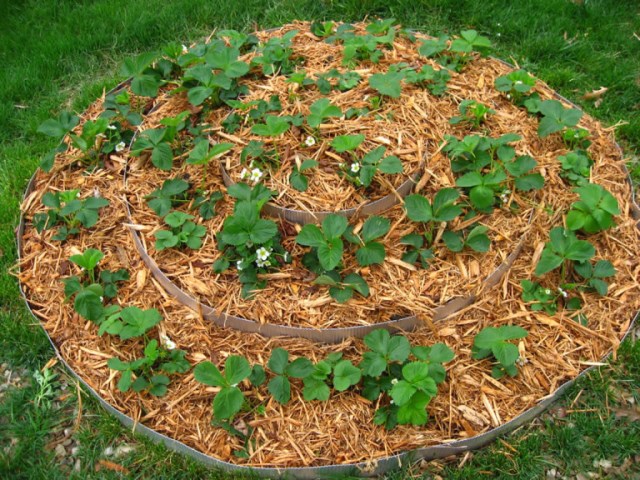Strawberry mulching is an agrotechnical method that makes it easier for the gardener to work and prevent crop diseases. A good knowledge of the technology and timing of laying mulch, the characteristics of materials will help to solve many problems in the care of plants and increase yield. In this article we will talk about how to mulch strawberries, how you can sprinkle the beds and why.
Table of contents
What is mulching?
Proper development and fruiting of plants is impossible without regular soil formation. A crucial role in this is played by the surface layer of the soil. It is he who is most exposed to adverse factors. The rains wash out the minerals, the wind and temperature drops lead to draining and freezing.
These conditions are unfavorable for the activity of living soil organisms, which are an important link in the formation of humus. They move into deep layers, and the soil loses its fertility.
Mulching - covering the soil surface under plants with organic and inorganic materials. It protects it from all adverse factors. Increases the reproduction of living organisms, earthworms and beneficial insects, which together with organic acids form a fertile layer.
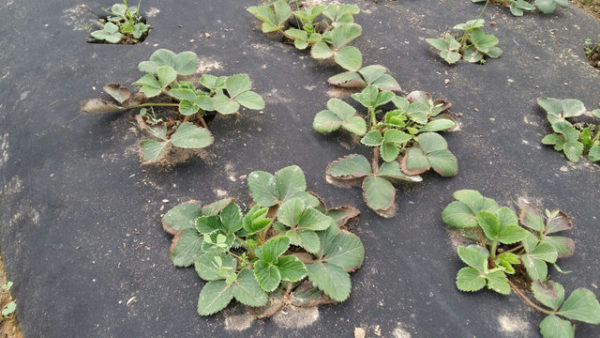
Mulch does not let in sunlight, which complicates the growth of weeds. The denser the material and the higher the layer is mulch, the more effective the protection against weeds.Thermal-controlled property of mulch protects the roots of plants from freezing, overheating and the effects of frost.
A layer of mulch reduces the evaporation of moisture from the soil, which reduces the need for irrigation. It complicates the ingress of viruses and fungal spores to strawberry roots, reducing the incidence of late blight, rhizoctoniosis, and verticillus. Ripe berries are not in contact with the soil, the percentage of decay is practically excluded.
In the process of decomposition in the organic mulch all the nutritional elements necessary for strawberries are formed. They slowly enter the soil throughout the growing season, maintaining the mineral exchange between the roots and the above-ground part of strawberries.
Duration of strawberry mulching
The soil under the plants should not be under a high layer of mulch all year round. In the spring she needs to warm up. Otherwise, the growing season of the culture will be strongly delayed. Mulch strawberries only after the appearance of floral ovaries.
Mulching can be done during the summer. Regardless of the term, the soil and plants need to be prepared before laying the material:
- loosen the soil;
- remove weeds, diseased leaves, extra mustaches;
- plenty of water;
- make a seasonal top dressing.
The term of underwinter strawberry mulching is the end of September, when the plant is prepared for rest. During this period, mulch is used as a thermostat. This is a protection against strong freezing of the soil in a snowless winter, damage to the roots during thaws.
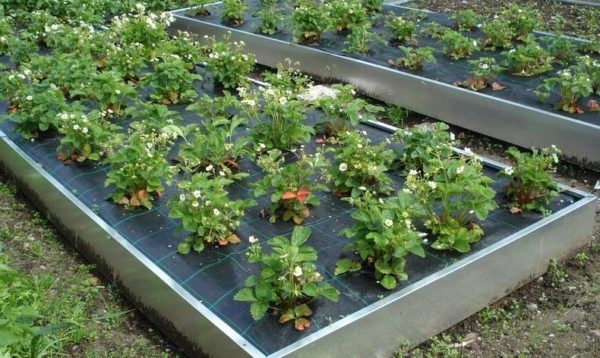
Selection of materials and rules for mulching
This review presents materials with all the necessary qualities for mulching strawberries. After evaluating their advantages and disadvantages, you can choose the optimal mulch for individual conditions and goals.
Straw
Straw - a recognized leader in all materials suitable strawberries. For mulching use only dry material.
The straw contains hard-decomposing fiber, which protects it from rapid decay. For the same reason, it is a bad power source, and in addition pulls nitrogen from the soil. To compensate for the loss of mineral and provide nourishment for bushes, straw is combined with compost or rotted manure.
The optimum layer of straw for loose soils is 15-20 cm. In a few days, it will settle to 5-7 cm. Cut straw is used on heavy clay soils and is laid with a layer of no more than 3-5 cm, renewing the surface every 15 days.
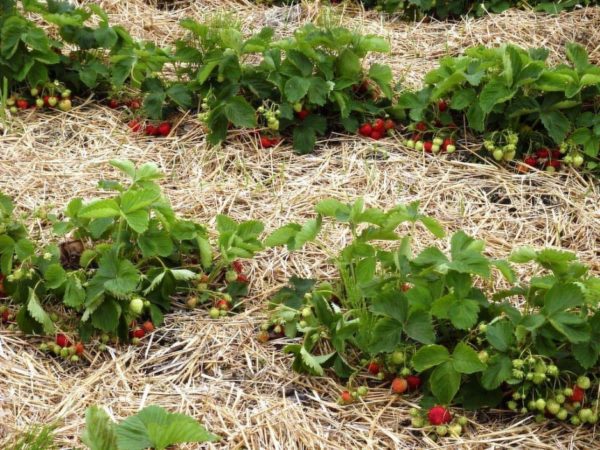
How to mulch strawberries with needles?
The advantage of the needles - a high content of volatile and bactericidal substances. It is a powerful defense against diseases and pests. The substances contained in coniferous materials improve the taste of strawberries.
In regions with hot summers should be considered: the needles poorly protects the soil from overheating.Needles fall on the ground in a loose layer through which weeds easily grow. It has been proven in practice: to protect against weeds, you need to lay a 30 cm layer. It is difficult and inappropriate.
For mulch, weathered and slightly yellowed pine needles are used. They are laid in a layer of 3-5 cm. In the spring, the old mulch is renewed or embedded in the ground during weeding.
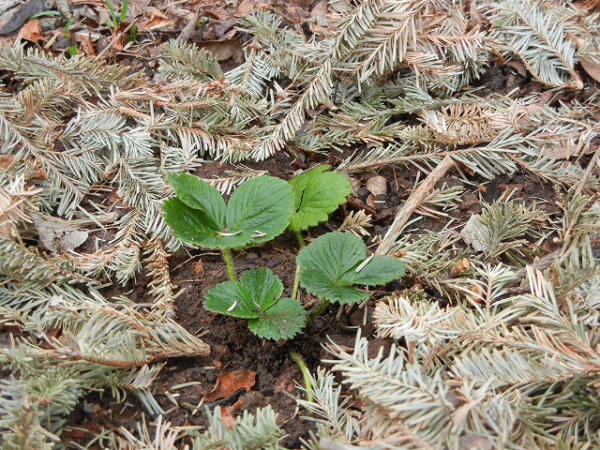
Hay, fresh grass and green manure
Is it possible or not to fill the berry with hay or fresh grass? These herbal ingredients contain easily decomposing fiber and provide rich nutrition to strawberries. But only for a short time.
Rapid decomposition leads to the depletion of a thin layer of mulch and rotting of the lower layers of high. When rotting plant waste causes strawberry poisoning by rotting products.
Hay suitable for temporary fertilizing strawberries. To create a favorable environment in the soil they will have to lay out a layer of 7-10 cm and replace every 15 days with fresh mulch. It is very labor intensive.Before laying, the cut grass is dried, plants are removed with abundant ripe seeds. The optimum layer is 3-5 cm.
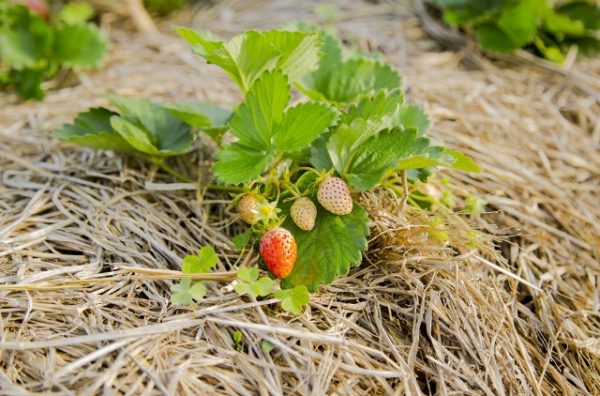
Tree bark
For mulching strawberries used pine bark or larch small or medium fraction. Tannins in them contain little, so the acidification of the soil will not. This is the most durable material for mulch, suitable for underwinter mulching. It will last up to 5 years.
The bark well protects the soil from overheating and freezing, gives an aesthetic look to the garden bed, but it is relatively worse in retaining moisture. Need more frequent watering. The required layer of mulch is 5-7 cm.

Sawdust
Sawdust decompose slowly, so do not consider them as a power source. For the same reason, sawdust can last up to 3 years. The rough surface of such mulch complicates the movement of slugs and snails, they become smaller.
For mulching, newsprint is spread over the surface of the ground, sawdust is laid on top of a layer of 5 cm. Sawdust is suitable for use in summer and before winter.
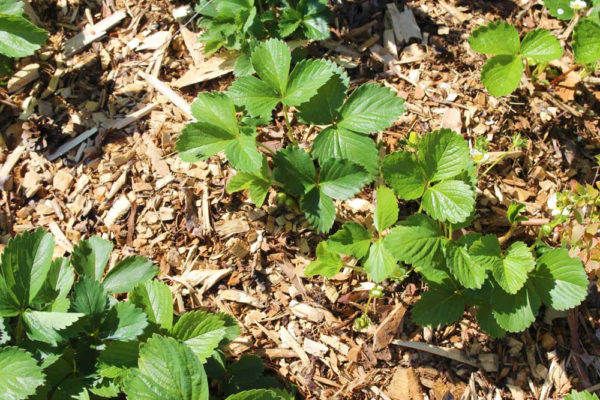
How to use cardboard?
Cardboard can be used to regulate the optimal environment on the ground surface. For this spring, large pieces of cardboard are laid overlapped between bushes, leaving holes only around bushes. Edges and joints of cardboard fix heavy objects.
Watering and feeding is carried out through the holes. To feed strawberries during the summer, a 3-5 cm layer of compost can be laid out under the cardboard.

Spandbond as mulch
This is a geosynthetic material.produced by special technology. It does not transmit light, maintains temperature and moisture in the soil. Through spandbond can be carried out irrigations and fertilizers.
Famous companies:
- Agrin (Ukraine);
- Agrotex (Russia);
- Lutrasil (Germany);
- Agil (France);
- Plant Protex (Poland).
Before planting strawberry seedlings spread it on the surface of the beds and make cuts in the places of the future holes. The edges of the spandbond are fixed with pins or heavy objects. To mulch already planted plants, agrotextiles are spread between rows, covering the surface of the soil as much as possible around the bushes.
Spandbond can be used all year round.It is resistant to putrefactive bacteria, mechanical effects and low temperatures. Service life 3 years.

How to mull the berry film?
For mulching strawberries use a black film with a thickness of 30 microns. Film service life up to 3 years. For one season, you can apply a thinner material. For hot regions, manufacturers offer a film with a white surface and black backing. It simultaneously reflects the sun's rays and retains moisture.
Technology laying mulch from the film is similar to spunbond. Only watering in this case will organize a micro-drop under the film or be watered locally through the holes.
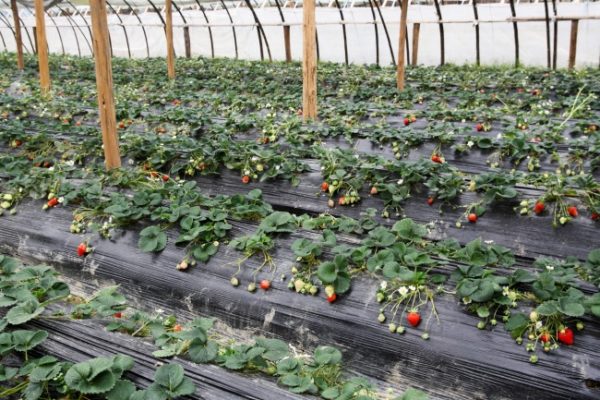
The benefits and harms of mulching in spring or autumn
Mulching strawberries causes heated debate among gardeners, during which you can hear diametrically opposed opinions.There are allegations of an unusually high yield after applying mulch and also of its negative effect on strawberries. Evaluation of the advantages and disadvantages will help to better understand the mulching.
Benefits
Depending on the applied material, mulching helps to solve many problems of the gardener.
It:
- prevention of overheating of the soil in summer and hypothermia in winter;
- soil moisture retention;
- reduction of weeds;
- protection against the entry of pathogens to the soil;
- soil erosion prevention;
- protection from rotting of ripe berries in rainy summer;
- preservation of soil looseness;
- the formation of a greater number of adventitious roots;
- reduction terms of ripening.
This impressive list entails a large expenditure of labor and money when doing them separately.
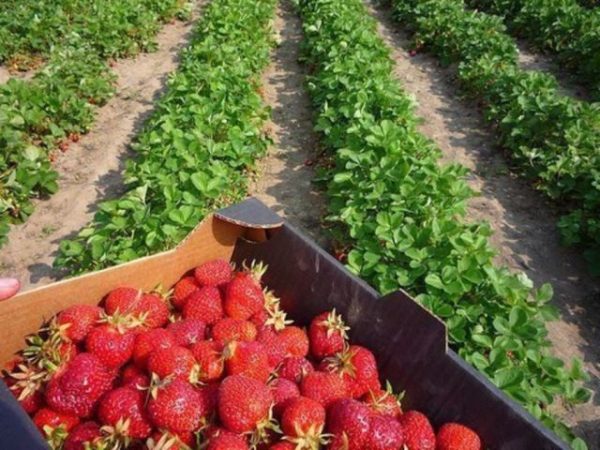
disadvantages
Gardeners call breeding slugs and snails one of the disadvantages of mulching.. For them, the wet inner layer of mulch becomes a refuge on dry summer days, and decaying organic matter is food. Conditions for pests really attractive.
This is not a reason for refusing to mulch.
Another disadvantage of mulch is rotting of the lower layers in a rainy summer or when laying on heavy clay soil. This problem is solved simply. It is necessary to focus on the regional climate, not to lay a high layer on clay soils, to regularly control the mulch during the season.
Strawberry mulching with long-term materials can play a bad role in return frosts. In this case, all the heat will remain in the soil, increasing the negative impact of freezing on the above-ground part of strawberries. Tracking the weather forecast will help in time to cover the plants.
The attraction of rodents, insects and birds is also called a minus grumble. However, it is difficult to consider a specific disadvantage. A garden with an abundance of vegetable and fruit crops is in itself attractive for their potential pests.
Experts are sure that poor knowledge of the characteristics of materials, the soil on the site and the regional climate lead to a bad experience.It is important to note that mulching does not exclude other types of strawberry care, therefore, it cannot be treated as a solution to all problems.
